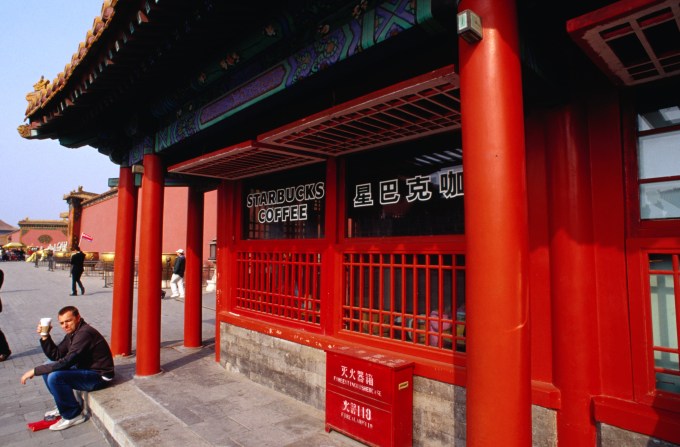Luckin Coffee is the most energizing IPO in recent memory, and not just because it sells caffeine.
Most venture-backed startups can take a decade to reach the public markets. Luckin cut that time down to about 18 months. Founder Jenny Qian Zhiya opened a trial coffee shop in Beijing, with a focus on rapid coffee delivery and mobile app ordering. Fast forward to today, and the company’s 2,370 stores conducted nearly 17 million transactions in the most recent quarter ending March 31.
Now Luckin — which can barely offer year-over-year comparables — intends to list its American depository shares (ADSs) on Nasdaq in the coming weeks, hoping to raise over $500 million through the IPO.
Understanding and going long or short on this company requires that we drop the facile analogies (aka it’s Starbucks!), understand the context of startup growth in China, and take a (rare) bet on a high-flying growth company in the public markets.
The incredibly useless Starbucks analogy

Lonely Planet via Getty Images
There is nothing in the United States that compares to Luckin. But that hasn’t stopped journalists, financial analysts, and what I suspect is Luckin’s own PR folks from making the obvious coffee chain comparison.
There is a huge danger to using analogies to understand any startup inventing a new market. Just as many VCs passed on UberCab because they couldn’t see how a black-car-on-demand service could possibly grow to venture scale, it’s easy to like or dismiss Luckin while wearing Starbucks green-tinted glasses. That analogy danger is even more manifest for a startup with only a scant few months of operating history.
Coffee is a highly-segmented market with diverse supply chains and retail outlets. Some people drink instant coffee. Some people buy premium coffee beans and roast them at home. Some people head to a café to drink their coffee, while others buy a $1 brew at the nearby gas station. Others get “free” coffee at their offices.
Starbucks founder Howard Schultz has called the company’s cafés a “third space,” a place not just to buy coffee, but to relax and meet with friends and business colleagues outside of the home (first space) and office (second space). In other words, it’s neutral territory.
While our image of Starbucks is probably one of its thousands of locations, like the coffee market itself, “Starbucks” is complicated as it has moved beyond opening new stores. The company sells its beans and other products into the retail channel as you can find in many American grocery stores. It has in-store cafés in chains like Target and Barnes & Noble. It also has an expanding (although slowing down) line of premium cafés known as Starbucks Reserve. In other words, there is an image of “Starbucks” and then the actual complicated reality of a massive multi-national company that competes in a range of coffee market segments.
Turning our attention to Luckin then, the comparison with Starbucks is usually about scale. Luckin has 2,370 stores across China according to its F-1, while Starbucks has roughly 3,500 in the country, albeit with thousands more theoretically on the way.
But, Luckin doesn’t offer a store in the sense of a Starbucks café. In fact, only 109 of its stores are what it dubs “relax stores.” Instead, the vast majority of its retail footprint (2,163 locations) are “pick-up stores” (which are often little more than a coffee kiosk) and a handful more (98) are “delivery kitchens.”
Luckin is a coffee distribution network operated via app, and there really isn’t a comp for this sort of business in the United States (or really China, for that matter). Even in the delivery capital of New York City, the idea that you can order a single cup of coffee for delivery seems completely … foreign, even if your local bagel shop will literally do so if you place an order and pay a delivery fee. Luckin is perhaps better analogized with Pizza Hut than with Starbucks if you must, but to be clear: this is a new market, both in China where coffee consumption is far lower, and also globally, in the sense of coffee delivery.
What’s the market size of coffee delivery? How many people would rather stay at their desk and have their coffee delivered versus walking down the street and getting a little fresh air? How many group orders will come from offices? How many offices would eschew coffee makers in lieu of delivery? There are so many questions, but at least in my mind, the market has to be substantial.
That’s perhaps partially why Starbucks has now partnered with Alibaba-owned ele.me to offer its own delivery-oriented coffee services. If this market turns out to be massive, it doesn’t want to be left behind with the economics of retail. The hope may well be that Luckin trailblazes this new market, but the Starbucks brand locks in this new customer.
Losing money, Chinese style

John M Lund Photography Inc via Getty Images
The other challenge with understanding Luckin is contextualizing its red ink. And let’s be clear: you need a lot of red in the inkwell just to write out this company’s meager available financial results.
In its most recent quarter ended March 31, the company generated revenues of $71.3 million ($53.8 million of which was from “freshly-brewed products”), while it sustained operating costs of $149.8 million, for an operating loss of $78.5 million ($82.2 million net loss).
On one hand, generating nearly $72 million in revenue within the first two years of a startup’s life is exceptional by basically any standard. Then again, if you are selling dollars for $0.50 a piece (or, you know, renminbi), it’s pretty easy to ratchet up the revenue while swimming in the growing rivers of red ink. And indeed, the company spent $25.0 million on marketing costs last quarter.
Are these results good or bad? There are two big difficulties in evaluating these numbers.
First, Chinese startups are well-known for spending heavily on sales and marketing costs to lock in market share, and then using network effects to protect their business while they raise prices or build alternative, revenue-generating products. That sort of extremely high early spend has been key to the rise of Meituan-Dianping, for instance. Chinese startups (and their venture capital backers) are much more willing than their American peers to spend for immediate growth today rather than more sustainable losses for the long-term.
The other challenge is understanding the unit economics of Luckin’s stores. As in the (pre-)analysis I did on WeWork for Extra Crunch a few weeks ago, we need to understand how each kiosk performs and its individual margin trajectory. Luckin separated out its pre-launch store costs into their own line item (note: those costs are not too significant), but that doesn’t give us nearly enough context to understand the specific operating performance of its stores.
Take, for instance, an operating wrinkle in Luckin’s F-1: the company’s performance in its last quarter before filing was lackluster. The average monthly transacting customers practically flatlined, ending at 4.4 million in the quarter ending March 31, compared to 4.3 million in the previous quarter (and 1.9 million two quarters ago). Its average monthly total items sold also declined slightly to 16.3 million from 17.6 million in the quarter before.
What’s challenging to understand here is just how much of an impact Chinese New Year had on these numbers. The holiday essentially shuts down China for one to two weeks, and so reasonably would have had a large impact on Luckin’s financial results. But, to what degree? Did the holiday cut orders by 25% last quarter and thus explains most of the decline, or was it a smaller issue, and there is something more fundamentally wrong with the company’s growth strategy? Without better operational data that will only come with time, it is essentially impossible to judge such aggregate metrics.
A rare growth startup on a major exchange
In many ways then, investing in Luckin Coffee is a shot in the dark. Its numbers are awe-dropping, at least until the current quarter. It’s pioneering a new segment in a relatively new market in China, and therefore there is little comparative data to understand the total market opportunity.
Perhaps most importantly, Luckin Coffee today could be just Luckin in the future, as it potentially expands beyond just coffee and its small bites into a variety of tangential businesses. Given the pattern we’ve seen with companies like Tencent, Alibaba, and Meituan-Dianping, Luckin could use its customer base and start directing them to a flotilla of other services.
Assuming Luckin Coffee successfully concludes its IPO, all of us will suddenly have access to an extremely early-stage startup with potentially massive returns ahead of it, if it can survive its own cash-demolishing business operations. Fight the poor analogies, understand the unique aspects of this business, and either hodl, or short (shotr?).
This article was written with the assistance of Arman Tabatabai from New York
